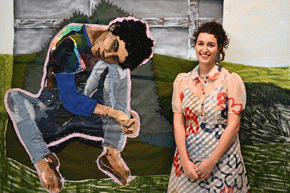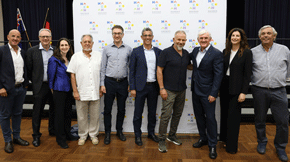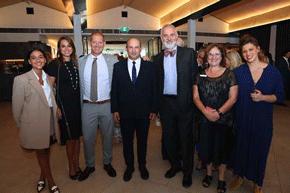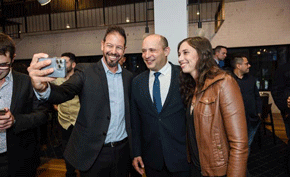From Australia’s past: Isaac Nachman Steinberg
Isaac Nachman Steinberg – never-tiring political thinker, activist, and realist

Isaac Nachman Steinberg
Isaac was born on 13 July 1888 in Dvinsk, Latvia. He was the son of Zerakh, an educated, religious, and wealthy merchant. Isaac spent most of his youth in Moscow, living in an environment characteristic of the Russian Jewish intelligentsia, but was educated at the gymnasium at Pernov Estonia. In 1906 he entered the Imperial Moscow University, where he studied law as well as the Talmud. Isaac then joined the Socialist Revolutionary Party and was exiled in 1907. Once free, he attended the University of Heidelberg, Germany, completed his law degree, and had to defend his doctoral thesis on Talmudic criminal law. Isaac then returned to Moscow in 1910 and started practising law. He defended Jewish victims of the tsarist regime and won endorsement from the Duma – the Russian Parliament. He married in 1914 and they had a son and two daughters. Isaac became an active member of the Moscow Jewish community, being considered as a future rabbi of Moscow.
During World War I, Isaac participated in activities of the Jewish Committee for Aiding Victims of War, as well as for a period as Commissar of Justice in Lenin’s government during the Bolsheviks’ short-lived coalition with the left wing of the SRP. After resigning from the government in protest at the Treaty of Brest-Litovsk, Isaac campaigned against the Bolsheviks and was banished in 1923 and he moved to Germany. In 1933, with war imminent, Isaac organised for his family to join him in London.
Isaac became active in the newly resurrected Freeland League for Jewish Territorial Colonisation, a body that attempted to find a refuge for persecuted European Jews. His work was subordinated to the urgent task of finding a territory in which to settle endangered Jews from Europe and planning future life in this territory. Rejecting Zionism on moral and political grounds, Isaac believed that the salvation of the Jewish people lay in autonomous Yiddish-speaking agricultural settlements under the political patronage of the colonial empires. The League selected the East Kimberley region in Australia’s northwest, planned to buy an area of seven million acres, and hoped to settle 75,000 Jewish refugees to develop the pastoral and agricultural industries. This was the same organisation that Caroline Jacobson, whose story appeared in last week’s ‘From Australia’s Jewish Past’, was associated with.
On 23 May 1939 Isaac arrived in Perth. A never-tiring publicist for the Kimberley Scheme, he appealed to people both on humanitarian grounds and by citing the officially declared need to populate northern Australia. He made a strong impression on all who met him. Geroge Farwell, a well-known author, described Isaac as having a ‘thick, short body’, a ‘black beard bristling from a pale, fine-grained face’, and ‘quizzing eyes beneath that broad dome of forehead’. In an interview conducted by the Freeland League, he was described as resembling a profit with his long hair. He ‘talked with great passion, laughed explosively’ and ‘gave way to abrupt splurges of anger if his ideas were challenged’.
On 24 May, The West Australian reported on his arrival. “Dr Steinberg made it clear at the outset that he was opposed to the creation of separate Jewish entities within Australia. Whatever scheme is adopted will have as its object the absorption of Jewish settlers so that they will become Australian citizens. The people are to be agricultural workers, and we have no desire that they should become a separate political entity.’’
A further article appeared on 8 June as follows:- “The Freeland League thought that the solution to the Jewish refugee problem did not lie only in the infiltration of individual persons or families, with their old occupations and trades into already developed areas in young countries. Rather, it believed in the large-scale colonisation of undeveloped areas. The movement had no political aspirations so that the settlers would be true citizens of the State, allowing them to settle within its boundaries. Another principle of the League was that the settlers in the new area should not compete with the labour or economy of the country where they settled. The means of colonisation would be provided by a responsible Jewish financial institution on business lines. The League thought that this project would be of benefit to Australia as a whole, which needed increased population and economic development.”
By early 1940 Isaac had gained the support of the Western Australian government, the Australasian Council of Trade Unions, several leading public figures, and major newspapers such as the Sydney Morning Herald, the Melbourne Argus, and the West Australian. He had also encountered opposition from the Bulletin, Smith’s Weekly, some daily newspapers, and several politicians, whose arguments ranged from the practical to the xenophobic and racist. For their part, many Australian Jews criticised the proposal: some feared it would provoke a wave of antisemitism, while others saw it as a threat to the Zionist cause.
Isaac had visited properties in the Kimberley region in 1939 owned and run by the Durack family who indicated they were open to the idea of selling their interests. They envisaged an agricultural miracle that would create new markets, boost exports, and stimulate economic growth. The land was said to be suitable for grazing cattle, sheep, and other animals, together with the large deposits of soil ideal for cereal and pasture crops.
On 25 August 1940, in a letter to Isaac – a copy of which is held in the State Records Office – Premier John Willcock endorsed the scheme with several conditions, including that a government official had to be present during the recruiting of migrants; the government would investigate the scheme before settlement started; government advisers would be stationed in the Kimberley, their salaries paid by the settlers; the schools must conform with Education Department guidelines and that the government be free from financial responsibility for any public works in the first three years of settlement.
Documents in the National Archives show how security agencies in Australia – no doubt conscious of Isaac’s earlier position in the Communist government in Russia – monitored his movements and intercepted his mail and telegrams.
In August 1940, Isaac presented his submission to Canberra, the matter being put in the in the too-hard basket. On 1 February 1941, the government decided to “defer consideration of the proposal”. Following an election in October 1941, Labor’s John Curtin, now Prime Minister, decided to shelve the issue. John Curtin wrote to Isaac on 15 July 1944 advising that the government, while sympathetic to the plight of Europe’s Jewish populations, had rejected the proposal, advising that it would not “depart from the long-established policy regarding alien settlements in Australia” and could not “entertain the proposal for a group settlement of an exclusive type.”.
Sadly, Isaac’s dream was over, and he left Australia for Canada in June 1943 to rejoin his family. He continued to wage a paper battle for the scheme, having approached prime ministers in 1945 and 1946 and publishing Australia—The Unpromised Land (London, 1948). All was to no avail. When Israel was established in 1948, he expressed concern at the idea of an exclusively Jewish nation rather than a bi-national Jewish-Arab nation. In the ensuing years, he advocated for a Jewish settlement outside Israel.
Isaac was a prolific writer in Russian, German, Yiddish, and English and wrote hundreds of articles and books, including an award-winning play about the Russian Revolution, which has been translated into many languages. A controversial political thinker and activist, he tried to remain true to the ideals of Russian populism, as well as to the commandments of Judaism.
Isaac died suddenly on 2 January 1957 in New York; his son and a daughter survived him. His close friend Erich Fromm wrote: ‘Many people would have called Isaac Steinberg a dreamer, or a visionary, and yet, he was one of the true, and unfortunately few, realists of our time’.
The AJHS acknowledges the following references in the preparation of this story:
Australian Dictionary of Biography (Beverley Hooper); Wikipedia, Centre for Jewish History; Yivo Archives; The West Australian – Malcolm Quekett – July 2022; Aust Jewish News 1989 – Leon Gettler; State Libraries of NSW and WA; SBS Australia – July 2023
 The Australian Jewish Historical Society is the keeper of archives from the arrival of the First Fleet in 1788 right up to today. Whether you are searching for an academic resource, an event, a picture or an article, AJHS can help you find that piece of historical material. The AJHS welcomes your contributions to the archives. If you are a descendent of someone of interest with a story to tell, or you have memorabilia that might be of significance for the archives, please make contact via www.ajhs.com.au or [email protected].
The Australian Jewish Historical Society is the keeper of archives from the arrival of the First Fleet in 1788 right up to today. Whether you are searching for an academic resource, an event, a picture or an article, AJHS can help you find that piece of historical material. The AJHS welcomes your contributions to the archives. If you are a descendent of someone of interest with a story to tell, or you have memorabilia that might be of significance for the archives, please make contact via www.ajhs.com.au or [email protected].












My article, “The three state manifestoes in support of the Kimberley Scheme, 1939-1940: texts and signatories’, published in the Australian Jewish Historical Society Journal, 15, 1 (1999), shows the wide range of prominent Australian men and women, of differing backgrounds and political views, who supported Dr Steinberg. It is available on the Society’s website.